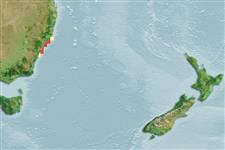>
Acropomatiformes (Oceanic basses) >
Creediidae (Sandburrowers)
Etymology: Creedia: Greek, kreesi, kreas = somebody that receives or keeps flesh (Ref. 45335).
Environment: milieu / climate zone / depth range / distribution range
Ecologia
marinhas associadas(os) a recifes; intervalo de profundidade 10 - 15 m (Ref. 9002). Subtropical
Southwest Pacific: Sydney, Australia.
Tamanho / Peso / Idade
Maturity: Lm ? range ? - ? cm
Max length : 7.0 cm TL macho/indeterminado; (Ref. 9002)
Descrição suscinta
Chaves de identificação | Morfologia | Morfometria
Espinhos dorsais (total) : 0; Raios dorsais (total) : 14 - 16; Espinhos anais: 0; Raios anais : 25 - 28; Vértebras: 45 - 47. Sandy colored dorsally, translucent ventrally; fins transparent (Ref. 9002).
Occurs in clean sand areas in the vicinity of rocky reefs (Ref. 9002). Buries deep in sand (Ref. 9002).
Ciclo de vida ou comportamento de acasalamento
Maturities | Reprodução | Spawnings | Egg(s) | Fecundities | Larvas
Kuiter, R.H., 1993. Coastal fishes of south-eastern Australia. University of Hawaii Press. Honolulu, Hawaii. 437 p. (Ref. 9002)
Status na Lista Vermelha da UICN (Ref. 130435)
Ameaça para os humanos
Harmless
Uso pelos humanos
Ferramentas
Relatórios especiais
Baixar XML
Fontes da internet
Estimates based on models
Preferred temperature (Ref.
123201): 20.8 - 22.1, mean 21.3 °C (based on 4 cells).
Índice de diversidade filogenética (Ref.
82804): PD
50 = 0.5625 [Uniqueness, from 0.5 = low to 2.0 = high].
Bayesian length-weight: a=0.00102 (0.00046 - 0.00225), b=3.06 (2.88 - 3.24), in cm total length, based on all LWR estimates for this body shape (Ref.
93245).
Nível Trófico (Ref.
69278): 3.3 ±0.4 se; based on size and trophs of closest relatives
Fishing Vulnerability (Ref.
59153): Low vulnerability (10 of 100).
